engine FIAT IDEA 2009 1.G Repair Manual
[x] Cancel search | Manufacturer: FIAT, Model Year: 2009, Model line: IDEA, Model: FIAT IDEA 2009 1.GPages: 210, PDF Size: 3.62 MB
Page 175 of 210
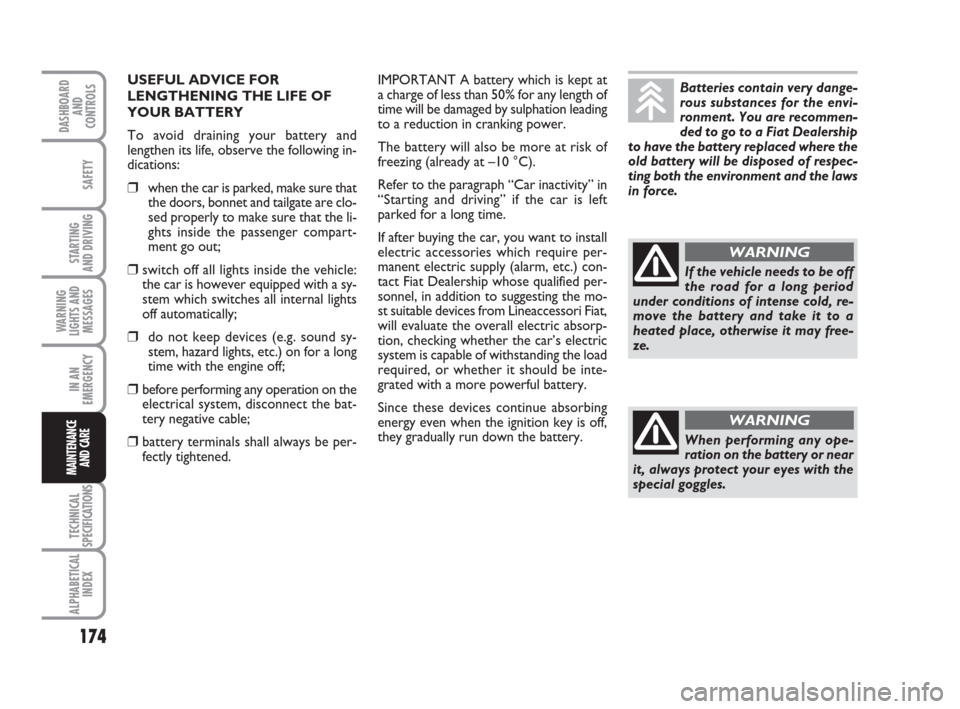
174
STARTING
AND DRIVING
IN AN
EMERGENCY
TECHNICAL
SPECIFICATIONS
ALPHABETICAL
INDEX
DASHBOARD
AND
CONTROLS
SAFETY
WARNING
LIGHTS AND
MESSAGES
MAINTENANCE
AND CARE
IMPORTANT A battery which is kept at
a charge of less than 50% for any length of
time will be damaged by sulphation leading
to a reduction in cranking power.
The battery will also be more at risk of
freezing (already at –10 °C).
Refer to the paragraph “Car inactivity” in
“Starting and driving” if the car is left
parked for a long time.
If after buying the car, you want to install
electric accessories which require per-
manent electric supply (alarm, etc.) con-
tact Fiat Dealership whose qualified per-
sonnel, in addition to suggesting the mo-
st suitable devices from Lineaccessori Fiat,
will evaluate the overall electric absorp-
tion, checking whether the car’s electric
system is capable of withstanding the load
required, or whether it should be inte-
grated with a more powerful battery.
Since these devices continue absorbing
energy even when the ignition key is off,
they gradually run down the battery. USEFUL ADVICE FOR
LENGTHENING THE LIFE OF
YOUR BATTERY
To avoid draining your battery and
lengthen its life, observe the following in-
dications:
❒when the car is parked, make sure that
the doors, bonnet and tailgate are clo-
sed properly to make sure that the li-
ghts inside the passenger compart-
ment go out;
❒switch off all lights inside the vehicle:
the car is however equipped with a sy-
stem which switches all internal lights
off automatically;
❒do not keep devices (e.g. sound sy-
stem, hazard lights, etc.) on for a long
time with the engine off;
❒before performing any operation on the
electrical system, disconnect the bat-
tery negative cable;
❒battery terminals shall always be per-
fectly tightened.Batteries contain very dange-
rous substances for the envi-
ronment. You are recommen-
ded to go to a Fiat Dealership
to have the battery replaced where the
old battery will be disposed of respec-
ting both the environment and the laws
in force.
If the vehicle needs to be off
the road for a long period
under conditions of intense cold, re-
move the battery and take it to a
heated place, otherwise it may free-
ze.
WARNING
When performing any ope-
ration on the battery or near
it, always protect your eyes with the
special goggles.
WARNING
Page 179 of 210
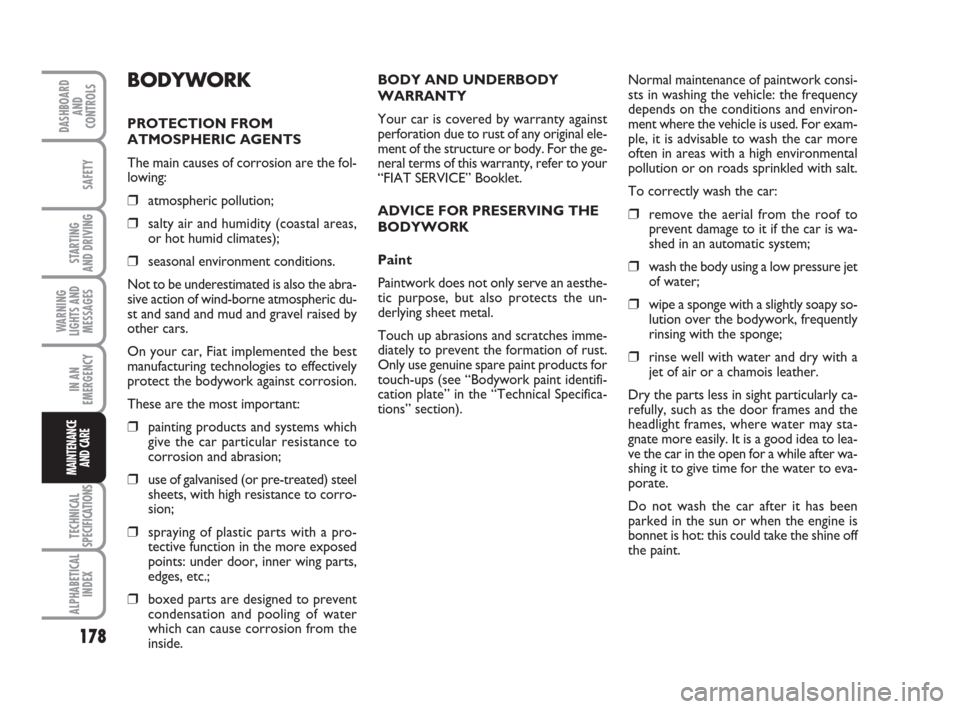
178
STARTING
AND DRIVING
IN AN
EMERGENCY
TECHNICAL
SPECIFICATIONS
ALPHABETICAL
INDEX
DASHBOARD
AND
CONTROLS
SAFETY
WARNING
LIGHTS AND
MESSAGES
MAINTENANCE
AND CARE
BODYWORK
PROTECTION FROM
ATMOSPHERIC AGENTS
The main causes of corrosion are the fol-
lowing:
❒atmospheric pollution;
❒salty air and humidity (coastal areas,
or hot humid climates);
❒seasonal environment conditions.
Not to be underestimated is also the abra-
sive action of wind-borne atmospheric du-
st and sand and mud and gravel raised by
other cars.
On your car, Fiat implemented the best
manufacturing technologies to effectively
protect the bodywork against corrosion.
These are the most important:
❒painting products and systems which
give the car particular resistance to
corrosion and abrasion;
❒use of galvanised (or pre-treated) steel
sheets, with high resistance to corro-
sion;
❒spraying of plastic parts with a pro-
tective function in the more exposed
points: under door, inner wing parts,
edges, etc.;
❒boxed parts are designed to prevent
condensation and pooling of water
which can cause corrosion from the
inside.BODY AND UNDERBODY
WARRANTY
Your car is covered by warranty against
perforation due to rust of any original ele-
ment of the structure or body. For the ge-
neral terms of this warranty, refer to your
“FIAT SERVICE” Booklet.
ADVICE FOR PRESERVING THE
BODYWORK
Paint
Paintwork does not only serve an aesthe-
tic purpose, but also protects the un-
derlying sheet metal.
Touch up abrasions and scratches imme-
diately to prevent the formation of rust.
Only use genuine spare paint products for
touch-ups (see “Bodywork paint identifi-
cation plate” in the “Technical Specifica-
tions” section).Normal maintenance of paintwork consi-
sts in washing the vehicle: the frequency
depends on the conditions and environ-
ment where the vehicle is used. For exam-
ple, it is advisable to wash the car more
often in areas with a high environmental
pollution or on roads sprinkled with salt.
To correctly wash the car:
❒remove the aerial from the roof to
prevent damage to it if the car is wa-
shed in an automatic system;
❒wash the body using a low pressure jet
of water;
❒wipe a sponge with a slightly soapy so-
lution over the bodywork, frequently
rinsing with the sponge;
❒rinse well with water and dry with a
jet of air or a chamois leather.
Dry the parts less in sight particularly ca-
refully, such as the door frames and the
headlight frames, where water may sta-
gnate more easily. It is a good idea to lea-
ve the car in the open for a while after wa-
shing it to give time for the water to eva-
porate.
Do not wash the car after it has been
parked in the sun or when the engine is
bonnet is hot: this could take the shine off
the paint.
Page 180 of 210
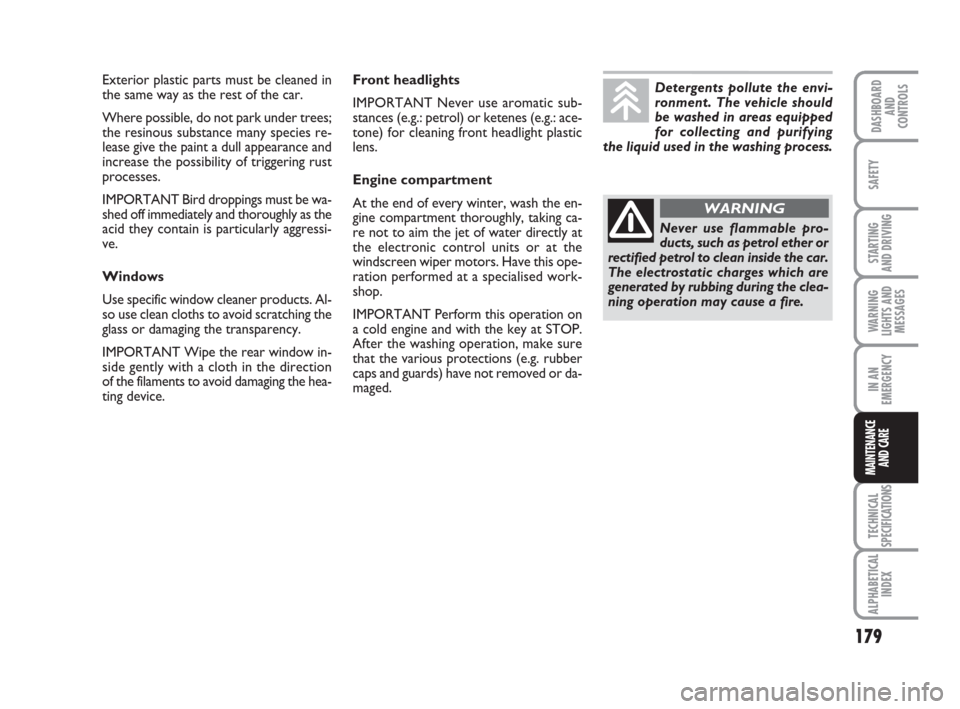
179
STARTING
AND DRIVING
IN AN
EMERGENCY
TECHNICAL
SPECIFICATIONS
ALPHABETICAL
INDEX
DASHBOARD
AND
CONTROLS
SAFETY
WARNING
LIGHTS AND
MESSAGES
MAINTENANCE
AND CARE
Exterior plastic parts must be cleaned in
the same way as the rest of the car.
Where possible, do not park under trees;
the resinous substance many species re-
lease give the paint a dull appearance and
increase the possibility of triggering rust
processes.
IMPORTANT Bird droppings must be wa-
shed off immediately and thoroughly as the
acid they contain is particularly aggressi-
ve.
Windows
Use specific window cleaner products. Al-
so use clean cloths to avoid scratching the
glass or damaging the transparency.
IMPORTANT Wipe the rear window in-
side gently with a cloth in the direction
of the filaments to avoid damaging the hea-
ting device.Front headlights
IMPORTANT Never use aromatic sub-
stances (e.g.: petrol) or ketenes (e.g.: ace-
tone) for cleaning front headlight plastic
lens.
Engine compartment
At the end of every winter, wash the en-
gine compartment thoroughly, taking ca-
re not to aim the jet of water directly at
the electronic control units or at the
windscreen wiper motors. Have this ope-
ration performed at a specialised work-
shop.
IMPORTANT Perform this operation on
a cold engine and with the key at STOP.
After the washing operation, make sure
that the various protections (e.g. rubber
caps and guards) have not removed or da-
maged.Detergents pollute the envi-
ronment. The vehicle should
be washed in areas equipped
for collecting and purifying
the liquid used in the washing process.
Never use flammable pro-
ducts, such as petrol ether or
rectified petrol to clean inside the car.
The electrostatic charges which are
generated by rubbing during the clea-
ning operation may cause a fire.
WARNING
Page 182 of 210
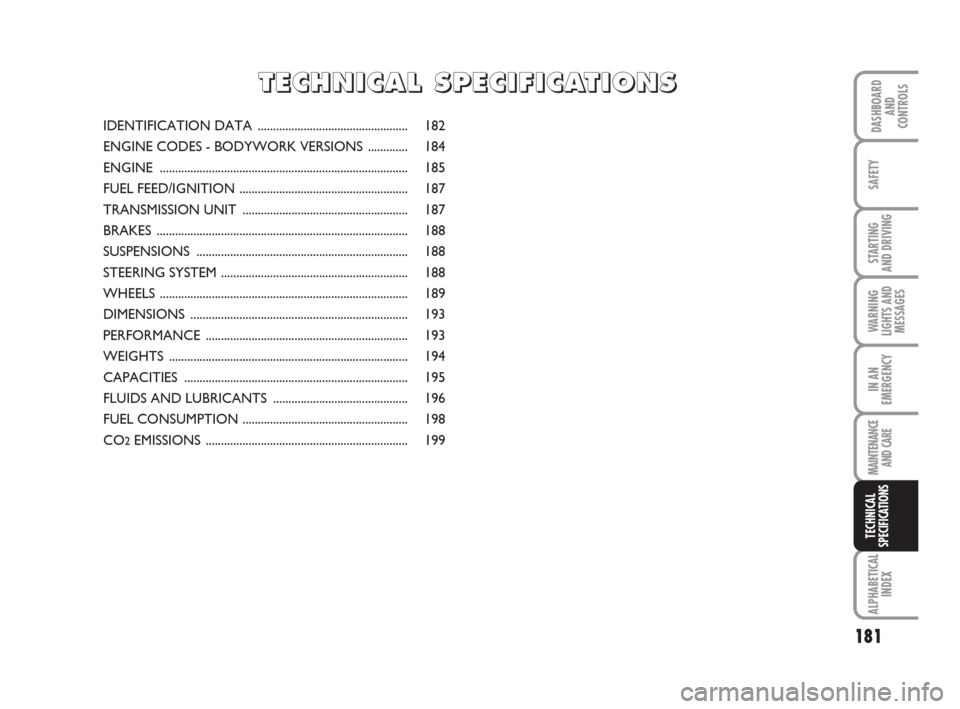
181
STARTING
AND DRIVING
IN AN
EMERGENCY
MAINTENANCE
AND CARE
ALPHABETICAL
INDEX
DASHBOARD
AND
CONTROLS
SAFETY
WARNING
LIGHTS AND
MESSAGES
TECHNICAL
SPECIFICATIONS
IDENTIFICATION DATA ................................................. 182
ENGINE CODES - BODYWORK VERSIONS ............. 184
ENGINE ................................................................................. 185
FUEL FEED/IGNITION ....................................................... 187
TRANSMISSION UNIT ...................................................... 187
BRAKES .................................................................................. 188
SUSPENSIONS ..................................................................... 188
STEERING SYSTEM ............................................................. 188
WHEELS ................................................................................. 189
DIMENSIONS ....................................................................... 193
PERFORMANCE .................................................................. 193
WEIGHTS .............................................................................. 194
CAPACITIES ......................................................................... 195
FLUIDS AND LUBRICANTS ............................................ 196
FUEL CONSUMPTION ...................................................... 198
CO
2EMISSIONS .................................................................. 199
T T
E E
C C
H H
N N
I I
C C
A A
L L
S S
P P
E E
C C
I I
F F
I I
C C
A A
T T
I I
O O
N N
S S
Page 183 of 210

182
STARTING
AND DRIVING
MAINTENANCE
AND CARE
ALPHABETICAL
INDEX
DASHBOARD
AND
CONTROLS
SAFETY
WARNING
LIGHTS AND
MESSAGES
TECHNICAL
SPECIFICATIONS
IDENTIFICATION DATA
We recommend taking note of the iden-
tification codes. The identification data are
printed on labels fig. 1in the following po-
sitions:
1- Model plate
2- Chassis marking.
3- Bodywork paint identification plate.
4- Engine marking.
MODEL PLATE
fig. 2
This plate is fitted to the engine compart-
ment front crossmember and contains the
following data:
B- Type-approval number.
C- Vehicle type code.
D- Chassis number.
E- Maximum vehicle weight fully loaded.F- Maximum vehicle weight fully loaded
with trailer.
G- Maximum vehicle weight on front ax-
le.
H- Maximum vehicle weight on rear ax-
le.
I- Engine Type
L- Bodywork version code.
M- Spare part code.
N- Smoke opacity index (for diesel en-
gines).
fig. 1
4
21
3
F0H0225mfig. 2F0H0760m
IN AN
EMERGENCY
Page 184 of 210

183
STARTING
AND DRIVING
IN AN
EMERGENCY
MAINTENANCE
AND CARE
ALPHABETICAL
INDEX
DASHBOARD
AND
CONTROLS
SAFETY
WARNING
LIGHTS AND
MESSAGES
TECHNICAL
SPECIFICATIONS
CHASSIS MARKING fig. 3
This is printed on the passenger com-
partment floor bed near the front right
seat.
The label can be accessed by lifting the
window in the mat and comprises:
❒vehicle model;
❒chassis number.
fig. 3F0H0227m
fig. 4F0H0228m
BODYWORK PAINT
IDENTIFICATION PLATE fig. 4
This plate is applied to the bonnet and
shows the following data:
A- Paint manufacturer.
B- Colour name.
C- Fiat colour code.
D- Respray and touch up code.
ENGINE MARKING
It is stamped onto the cylinder block (pas-
senger compartment side) and shows the
type and the serial number.
Page 185 of 210
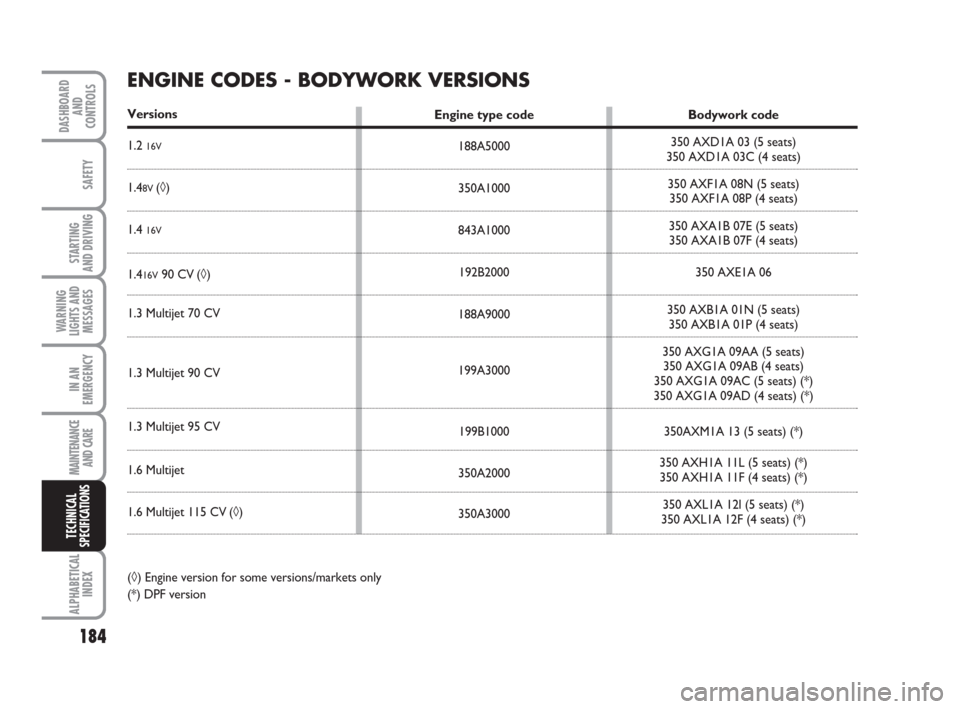
184
STARTING
AND DRIVING
IN AN
EMERGENCY
MAINTENANCE
AND CARE
ALPHABETICAL
INDEX
DASHBOARD
AND
CONTROLS
SAFETY
WARNING
LIGHTS AND
MESSAGES
TECHNICAL
SPECIFICATIONS
ENGINE CODES - BODYWORK VERSIONS
Versions
1.2
16V
1.48V (◊)
1.4 16V
1.416V90 CV (◊)
1.3 Multijet 70 CV
1.3 Multijet 90 CV
1.3 Multijet 95 CV
1.6 Multijet
1.6 Multijet 115 CV (◊)
Bodywork code
350 AXD1A 03 (5 seats)
350 AXD1A 03C (4 seats)
350 AXF1A 08N (5 seats)
350 AXF1A 08P (4 seats)
350 AXA1B 07E (5 seats)
350 AXA1B 07F (4 seats)
350 AXE1A 06
350 AXB1A 01N (5 seats)
350 AXB1A 01P (4 seats)
350 AXG1A 09AA (5 seats)
350 AXG1A 09AB (4 seats)
350 AXG1A 09AC (5 seats) (*)
350 AXG1A 09AD (4 seats) (*)
350AXM1A 13 (5 seats) (*)
350 AXH1A 11L (5 seats) (*)
350 AXH1A 11F (4 seats) (*)
350 AXL1A 12l (5 seats) (*)
350 AXL1A 12F (4 seats) (*)
(◊) Engine version for some versions/markets only
(*) DPF versionEngine type code
188A5000
350A1000
843A1000
192B2000
188A9000
199A3000
199B1000
350A2000
350A3000
Page 186 of 210
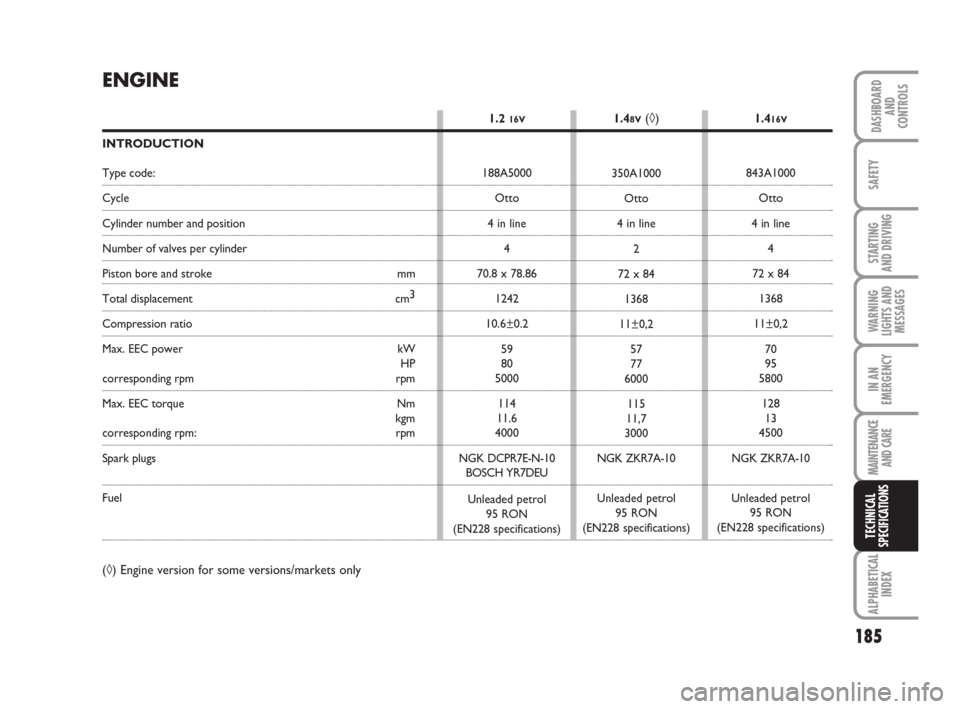
185
STARTING
AND DRIVING
IN AN
EMERGENCY
MAINTENANCE
AND CARE
ALPHABETICAL
INDEX
DASHBOARD
AND
CONTROLS
SAFETY
WARNING
LIGHTS AND
MESSAGES
TECHNICAL
SPECIFICATIONS
(◊) Engine version for some versions/markets only
ENGINE
INTRODUCTION
Type code:
Cycle
Cylinder number and position
Number of valves per cylinder
Piston bore and stroke mm
Total displacement cm3
Compression ratio
Max. EEC power kW
HP
corresponding rpm rpm
Max. EEC torque Nm
kgm
corresponding rpm: rpm
Spark plugs
Fuel
1.2 16V
188A5000
Otto
4 in line
4
70.8 x 78.86
1242
10.6±0.2
59
80
5000
114
11.6
4000
NGK DCPR7E-N-10
BOSCH YR7DEU
Unleaded petrol
95 RON
(EN228 specifications)1.4
16V
843A1000
Otto
4 in line
4
72 x 84
1368
11±0,2
70
95
5800
128
13
4500
NGK ZKR7A-10
Unleaded petrol
95 RON
(EN228 specifications) 1.4
8V(◊)
350A1000
Otto
4 in line
2
72 x 84
1368
11±0,2
57
77
6000
115
11,7
3000
NGK ZKR7A-10
Unleaded petrol
95 RON
(EN228 specifications)
Page 188 of 210
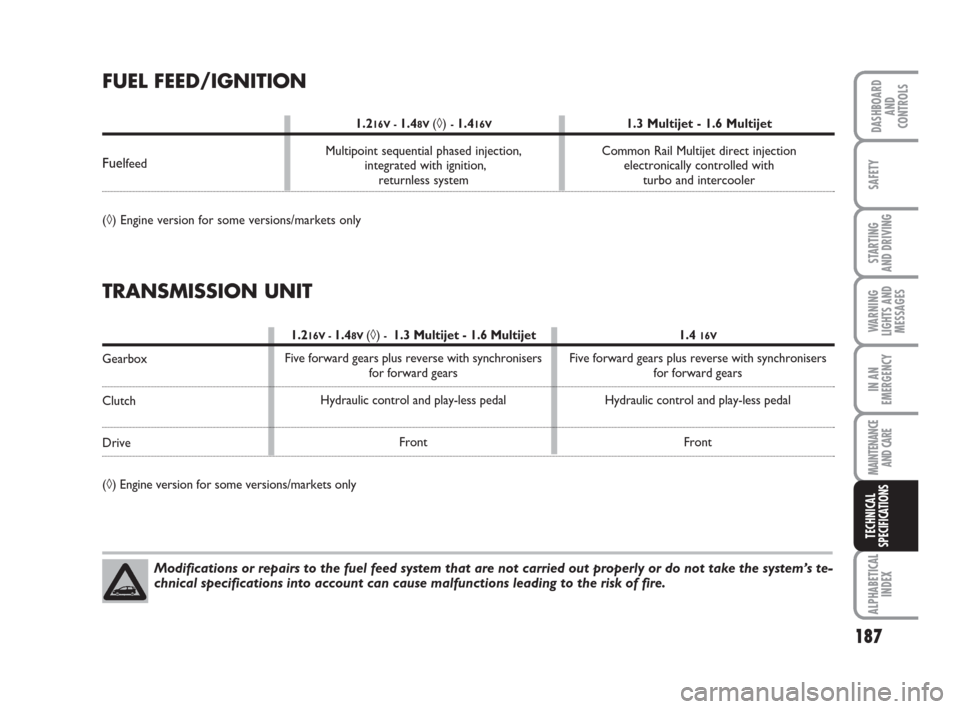
187
STARTING
AND DRIVING
IN AN
EMERGENCY
MAINTENANCE
AND CARE
ALPHABETICAL
INDEX
DASHBOARD
AND
CONTROLS
SAFETY
WARNING
LIGHTS AND
MESSAGES
TECHNICAL
SPECIFICATIONS
FUEL FEED/IGNITION
Fuelfeed
(◊) Engine version for some versions/markets only
TRANSMISSION UNIT
Gearbox
Clutch
Drive
(◊) Engine version for some versions/markets only1.3 Multijet - 1.6 Multijet
Common Rail Multijet direct injection
electronically controlled with
turbo and intercooler 1.2
16V - 1.48V (◊) - 1.416V
Multipoint sequential phased injection,
integrated with ignition,
returnless system
1.2
16V - 1.48V (◊) - 1.3 Multijet - 1.6 Multijet
Five forward gears plus reverse with synchronisers
for forward gears
Hydraulic control and play-less pedal
Front1.4 16V
Five forward gears plus reverse with synchronisers
for forward gears
Hydraulic control and play-less pedal
Front
Modifications or repairs to the fuel feed system that are not carried out properly or do not take the system’s te-
chnical specifications into account can cause malfunctions leading to the risk of fire.
Page 189 of 210
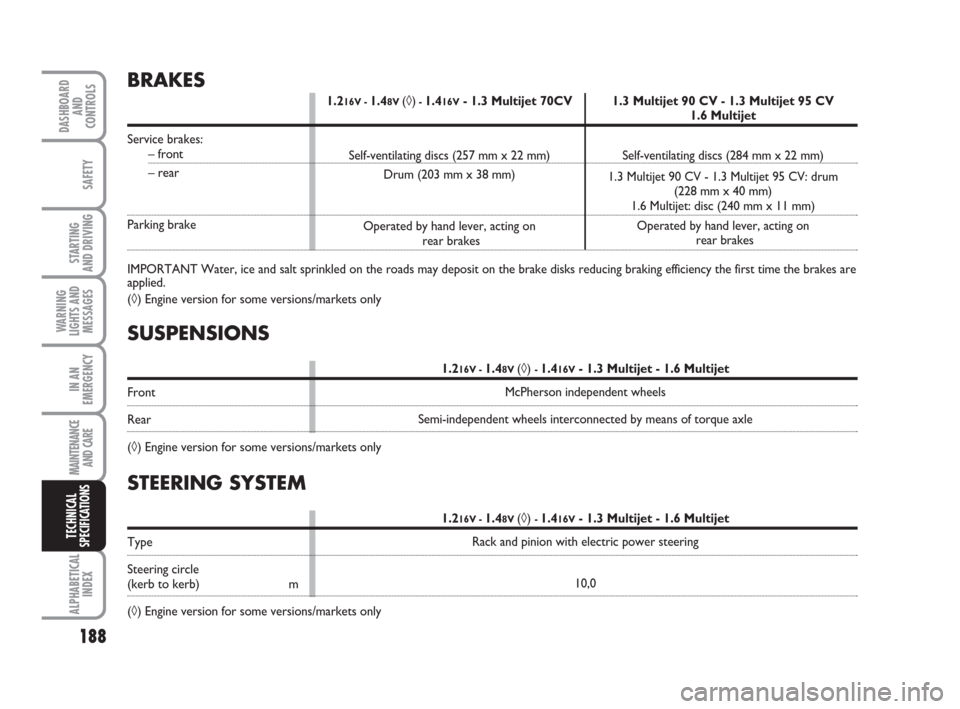
188
STARTING
AND DRIVING
IN AN
EMERGENCY
MAINTENANCE
AND CARE
ALPHABETICAL
INDEX
DASHBOARD
AND
CONTROLS
SAFETY
WARNING
LIGHTS AND
MESSAGES
TECHNICAL
SPECIFICATIONS
SUSPENSIONS
Front
Rear
(◊) Engine version for some versions/markets only1.2
16V - 1.48V (◊) - 1.416V- 1.3 Multijet - 1.6 Multijet
McPherson independent wheels
Semi-independent wheels interconnected by means of torque axle
STEERING SYSTEM
Type
Steering circle
(kerb to kerb) m
(◊) Engine version for some versions/markets only1.2
16V - 1.48V (◊) - 1.416V- 1.3 Multijet - 1.6 Multijet
Rack and pinion with electric power steering
10,0
BRAKES
Service brakes:– front
– rear
Parking brake
IMPORTANT Water, ice and salt sprinkled on the roads may deposit on the brake disks reducing braking efficiency the first time the brakes are
applied.
(◊) Engine version for some versions/markets only1.2
16V - 1.48V (◊)- 1.416V- 1.3 Multijet 70CV
Self-ventilating discs (257 mm x 22 mm)
Drum (203 mm x 38 mm)
Operated by hand lever, acting on
rear brakes1.3 Multijet 90 CV - 1.3 Multijet 95 CV
1.6 Multijet
Self-ventilating discs (284 mm x 22 mm)
1.3 Multijet 90 CV - 1.3 Multijet 95 CV: drum
(228 mm x 40 mm)
1.6 Multijet: disc (240 mm x 11 mm)
Operated by hand lever, acting on
rear brakes